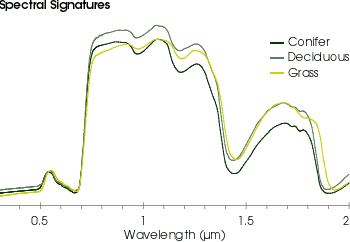

| How Scientists Differentiate Between Land Cover Types
Before scientists can transform raw satellite image data into land cover maps, they must decide on what categories of land cover they would like to use. Categories are simply the types of landscape that the scientists are trying to map and can vary greatly from map to map. For flood maps, there may be only two categories—dry land and wet land—while a standard global land cover map may have seventeen categories including closed shrub lands, savannas, evergreen needle leaf forest, urban areas, and ice/snow. The only requirement for any land cover category is that it have a distinct spectral signature that a satellite can record. As can
be seen through a prism, many different colors (wavelengths) make up the
spectra of sunlight. When sunlight strikes objects, certain wavelengths
are absorbed and others are reflected or emitted. The unique way in
which a given type of land cover reflects and absorbs light is known as
its spectral signature. Anyone who has flown over the midwestern United States has seen
evidence of this phenomenon. From an airplane window, the ground appears
as a patchwork of different colors formed by the fields of crops planted there.
The varying pigments of the leaves, the amount of foliage per square
foot, the age of the plants, and many other factors create this
tapestry. |

Land Cover Classification
| ||
 Most imaging satellites are sensitive to specific wavelengths of light, including infrared wavelengths that cannot be seen with the naked eye. Passive satellite remote sensors—such as those flown on Landsat 5, Landsat 7, and Terra—have a number of light detectors (photoreceptors) on board that measure the energy reflected or emitted by the Earth. One light detector records only the blue part of the spectrum coming off the Earth. Another observes all the yellow-green light and still another picks up on all the near-infrared light. The detectors scan the Earth's surface as the satellite travels in a circular orbit very nearly from pole-to-pole. To differentiate between types of land cover and their attributes, researchers manipulate the colors recorded by the satellite to get the combination of wavelengths that best distinguishes the spectral signature of the land cover they wish to identify. After an area of forest or water or grass is identified, they can outline the category on an easy-to-analyze, color-coded map. To verify their results, the scientists will often travel to the regions of interest and compare the results of the map with test sites on the ground. next: The Basic Vegetation Map
|